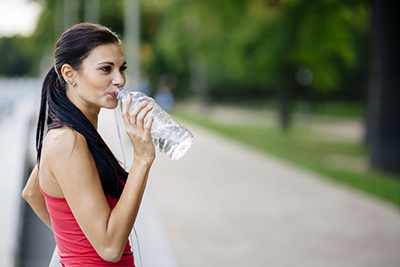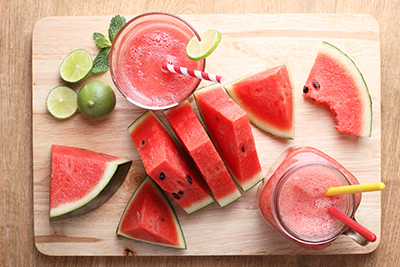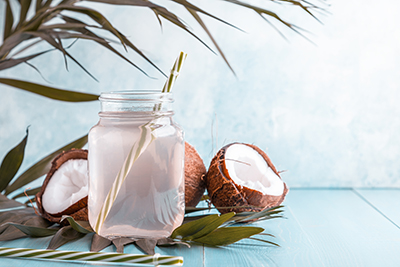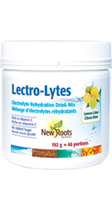Electrolyte-Replacing Foods to Eat this Summer: Naturopathic Considerations
As summer wears on, the long hot days fade into warm nights. For those of you who spend a lot of time outside, it can seem like you never really get a break from the heat. Hopefully, when you really get hot you can find some air conditioning, get into a shady spot, or cool off in some water. It is also important that you have plenty of cool water to drink, otherwise you can quickly become dehydrated and risk developing heat exhaustion or heat stroke.
Heat exhaustion is characterized by fatigue, headache, weakness, dizziness, nausea, muscle aches or cramps, excessive thirst, slow or weakened heartbeat, fainting, confusion or anxiety, agitation, and drenching sweats, often accompanied by cold, clammy skin or a sensation of prickly skin.[1]
There are two main causes for heat exhaustion. The first is being dehydrated. Excessive sweating without replenishing lost fluids, especially if you started out dehydrated, can quickly lead to severe dehydration and heat exhaustion. The second cause is salt and mineral depletion. Salt and other minerals are present in your sweat, so excessive sweating can result in depleted minerals, which can lead to muscle cramps, dizziness, nausea, and vomiting.[1]
Heat stroke is a more severe condition, which—if left untreated—could become life-threatening. Heat exhaustion can lead to heat stroke, although it could come on without the symptoms of heat exhaustion. During heat stroke, the body is unable to cool itself properly; internal body temperature can be between 104 °F (40 °C) and 106 °F (41 °C) or higher. Symptoms of heat stroke include throbbing headache; red, hot, and dry skin; lack of sweating; rapid, shallow breathing; rapid heartbeat; dizziness and light-headedness; nausea and vomiting; behavioural changes such as confusion, disorientation, or staggering; unconsciousness; and seizures.[2]
Some conditions that can lead to both heat exhaustion and heat stroke are hot temperatures with high humidity; intense or strenuous physical work; high blood pressure; smoking or tobacco use; drug abuse; heavy or long-term alcohol use; liver or kidney conditions; heart disease; obesity; underlying conditions that increase the chances of dehydration, including diabetes or hyperglycemia; and certain medications that increase the risk of dehydration, including medications for depression, insomnia, allergies, and poor circulation. Infants and children under 4 years old and adults over 65 years old are especially at risk, since their body is not as efficient at cooling itself.[3]
 If someone is suffering from heat stroke, seek medical attention immediately. You can also begin cooling the body down by dousing with cold water or placing ice packs behind the neck, under the armpits, and in the groin area.[2]
If someone is suffering from heat stroke, seek medical attention immediately. You can also begin cooling the body down by dousing with cold water or placing ice packs behind the neck, under the armpits, and in the groin area.[2]
Fortunately, there are ways to not only survive the heat, but even to do well in the heat. With a little preplanning, you can enjoy the summer while keeping yourself and your family safe. Plan for the day’s activities by putting plenty of water and some electrolyte-replacing foods and drinks in a cooler with ice. Below, you will find recommendations on what to take with you. Make sure you take enough for everyone in your group.
First and foremost, staying hydrated is an absolute must. Whether you are playing or working, make sure you take the time to drink water often. Plain cool or cold water is what your body needs the most. During profuse sweating, an electrolyte-recovery drink, commonly referred to as a sports drink, can help replace lost salt and minerals (electrolytes). These drinks are very effective at quickly helping your body recover, especially if you feel that you just can’t drink enough water to satisfy your thirst. The combination of electrolytes and sugar in water allows your body to immediately send it to your cells for use. Make sure that you continue drinking water between sports drinks to keep your kidneys hydrated and to prevent them from working too hard to filter excess electrolytes and sugar out of your body. Whether you buy premade electrolyte drinks or make your own, avoid artificial sweeteners; natural sweeteners make the drink effective. Natural sweeteners include sugar, fruit juice, honey, and other natural syrups.
A lot of tasty foods can help you stay hydrated while providing electrolytes in a form that your body can easily utilize. Fruit is a refreshing summer treat which provides water, natural sugar in the form of fructose, antioxidants, and important minerals (electrolytes).
Watermelon not only contains a lot of water, but it is also rich in electrolytes—and of course, it is wonderfully sweet. For a quick snack, cut the watermelon into bite-sized pieces before you leave home. Don’t forget to pack the salt if you like yours salty sweet. Pineapple is another good choice for refreshing a hot and weary body. Sweet and juicy, it also contains the enzyme bromelain which helps fight muscle fatigue and inflammation. Once again, prepare the pineapple before you leave home for immediate snacking.
Oranges and other citrus fruits are high in electrolytes and are also naturally refreshing; they can be eaten by the slice or squeezed into water. Kiwi fruit is high in potassium, an important electrolyte. Prepare them at home by scrubbing the skin under water with a vegetable brush; you can slice them or leave them whole. By eating the skin, you get the added benefit of extra fibre which helps stabilize blood sugar.[4]
 Quite a few vegetables can also help you fight dehydration and the heat. Cucumbers are refreshing eaten by the slice or by adding slices to water. Celery is 95% water and offers electrolytes such as potassium, sodium, magnesium, calcium, and phosphorus. Try dipping celery in peanut butter or other nut butters, or hummus for even more electrolytes (plus energy-sustaining protein and healthy plant-based fats). A salad chocked full of lettuce and veggies like carrots, tomatoes, and mushrooms can provide a refreshing boost in the middle of the day. Top with roasted and salted sunflower seeds, raisins, and olives for added flavour.[4][5] Toss with a dressing made from apple-cider vinegar to round out the electrolyte content. If a salad does not sound like something you want to mess with, consider using lettuce leaves to make wraps instead of using bread for sandwiches.
Quite a few vegetables can also help you fight dehydration and the heat. Cucumbers are refreshing eaten by the slice or by adding slices to water. Celery is 95% water and offers electrolytes such as potassium, sodium, magnesium, calcium, and phosphorus. Try dipping celery in peanut butter or other nut butters, or hummus for even more electrolytes (plus energy-sustaining protein and healthy plant-based fats). A salad chocked full of lettuce and veggies like carrots, tomatoes, and mushrooms can provide a refreshing boost in the middle of the day. Top with roasted and salted sunflower seeds, raisins, and olives for added flavour.[4][5] Toss with a dressing made from apple-cider vinegar to round out the electrolyte content. If a salad does not sound like something you want to mess with, consider using lettuce leaves to make wraps instead of using bread for sandwiches.
Besides drinking commercially-made sports drinks, you can make your own electrolyte-replacing sports drink with just a few ingredients. There are a lot of recipes on the internet, but here is a simple one:
- ¼ cup of lemon juice
- ¼ cup of lime juice
- 1 teaspoon of salt
- 1 whole squeezed orange (or one frozen can of orange juice)
- 1 litre of water
Hint: If this is a little too tart for you or the kids, add some honey or pineapple juice.[6]
 Coconut water is full of electrolytes and is naturally sweet, making it an instantly refreshing. Apple-cider vinegar can quickly help you recover, with potassium and magnesium. Try mixing a tablespoon of it in a glass of water along with a teaspoon of honey. Aloe vera juice is not only good for cooling hot skin, but it is also cooling to the body when taken internally. By itself, aloe juice tends to be bitter, so mix a tablespoon in juice or water with lemon and honey.[7]
Coconut water is full of electrolytes and is naturally sweet, making it an instantly refreshing. Apple-cider vinegar can quickly help you recover, with potassium and magnesium. Try mixing a tablespoon of it in a glass of water along with a teaspoon of honey. Aloe vera juice is not only good for cooling hot skin, but it is also cooling to the body when taken internally. By itself, aloe juice tends to be bitter, so mix a tablespoon in juice or water with lemon and honey.[7]
Once you are out of the heat for the day, consider consuming some form of organic, grass-fed dairy. Milk, cheese, yogurt, and kefir are all good sources of electrolytes.[8] I recommend not eating dairy while you are feeling very hot, as it could lead to stomach discomfort.
Perhaps one of the biggest things that you can do to help prevent heat-related illnesses is to make sure that you are properly hydrated to begin with before heading out into the heat. Avoid alcohol and caffeine, since they both act as diuretics. Excessive alcohol consumption before, during, and after being in the heat can also deplete your body of electrolytes. Along with starting out and staying hydrated, avoid wearing heavy, tight-fitting clothes, and limit time spent in places where there is little air flow such as vehicles or buildings without proper ventilation.[9]
When the temperature and humidity get high, remember to take breaks often, sit or lie in the shade, and drink plenty of water. Watch each other for signs of overheating, especially children and the elderly. If you are alone, pay attention to how you are feeling and whether you are sweating. Finally, if you have an opportunity to cool down by getting in the water or air conditioning, do it! You will be happy you did. Have a happy and safe summer!
References
- WebMD. Understanding Heat-Related Illness--Symptoms. · https://www.webmd.com/first-aid/understanding-heat-related-illness-symptoms · Updated 2019-07-30.
- WebMD. Heat Stroke: Symptoms and Treatment. · https://www.webmd.com/a-to-z-guides/heat-stroke-symptoms-and-treatment · Updated 2018-11-25.
- Huizen, J. “What is heat exhaustion?” Medical News Today. · https://www.medicalnewstoday.com/articles/319570.php · Updated 2018-01-16.
- Stanz, C. “7 juicy foods that prevent heat exhaustion and dehydration.” Wide Open Eats. · http://www.wideopeneats.com/7-juicy-foods-the-prevent-heat-exhaustion-and-dehydration/ · Posted 2019-05-30.
- Morrow, K. “What drinks and foods contain electrolytes?” Jillian Michaels. · https://getfit.jillianmichaels.com/drinks-foods-contain-electrolytes-2020.html
- [Fitday Editor.] “How to make a homemade electrolyte drink.” Fit Day. · https://www.fitday.com/fitness-articles/nutrition/healthy-eating/how-to-make-a-homemade-electrolyte-drink.html
- [No author listed.] “Natural healing: 10 home remedies to treat heat stroke.” NDTV Food. · https://food.ndtv.com/lists/natural-healing-10-home-remedies-to-treat-heat-stroke-765154 · 2018-04-16.
- Whitbread, D. “High electrolyte foods.” My Food Data. · https://www.myfooddata.com/articles/high-electrolyte-foods.php · Updated 2019-04-26.
- Hansen, K. “Do you have heat stroke or heat exhaustion? Learn the signs.” Healthline. · https://www.healthline.com/health/heat-stroke-vs-heat-exhaustion#symptoms · Reviewed 2016-09-09.
 Dr. Michelle Lo, ND
Dr. Michelle Lo, ND
She completed her undergraduate education at McMaster University in Kinesiology before attending the Canadian College of Naturopathic Medicine (CCNM).
drmichellend.com
 Dr. Melissa Cornish, HHC
Dr. Melissa Cornish, HHC
Dr. Cornish is versed in over 100 dietary theories and has over 20 years of studying and practicing holistic healing methods.

 Stores
Stores

